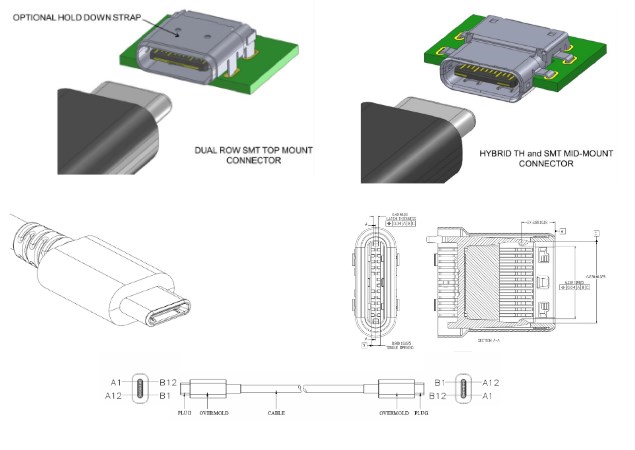- Home
- Laptops
- Laptops News
- Tiny, Reversible Type C USB Connector to Debut by 2015
Tiny, Reversible Type-C USB Connector to Debut by 2015

The USB 3.0 Promoter Group has announced that it has completed work on designing the much-anticipated USB Type-C connector. USB Type-C will replace the existing Type-A and Type-B used across millions of computers, peripherals and portable devices today. The single connector type will be reversible, making life easier for users who will not have to check which way to insert a USB plug into a port. The same connector will also be used at both ends of a USB cable.
The USB Type-C plug will be approximately the same size and shape as the current Micro-USB Type-B plug which is used by the majority of smartphones, tablets and peripherals available today for charging and data transfer.
While nothing about the USB protocol itself changes, the plugs are physically incompatible with existing USB ports. Passive adapters will be required to make devices with Type-C ports interoperable with current day PCs, cables and chargers. Cables with a Type-C connector on one end and a legacy connector on the other end will also necessarily be available.
It might still take several months for devices with USB Type-C ports to become available. Current USB 2.0 and 3.0 protocols will be fully supported, and no further revision will be necessary when USB 3.1 and subsequent versions are launched. More specific launch dates are not known, but the USB 3.0 Promoter Group consists of HP, Intel, Microsoft, Renesas, STMicroelectronics and Texas Instruments, which will encourage widespread support and adoption. The standard is not likely become mainstream for many years, thanks to the popularity of the existing standards.
In addition to supporting USB 3.1 speeds of up to 10Gbps (twice the speed of today's USB 3.0), the Type-C connector will allow for increased power delivery of up to 100W, which would be enough to charge a laptop or power an external 3.5-inch desktop hard drive as well as better resistance to electro-magnetic and radio frequency interference.
The connector consists of two rows of 12 pins each, such that either row will make contact with corresponding pins in the USB port depending on which way it is inserted. Devices will detect the relationship required and negotiate the transfer of power over USB when a cable is plugged in. A two-way mode is supported in addition to the traditional USB host-to-device roles.
The combination of all the new standards and capabilities will allow for new devices and scenarios such as monitors with built-in docks that can not only charge a connected laptop but also connect and provide power to multiple peripherals.
For the latest tech news and reviews, follow Gadgets 360 on X, Facebook, WhatsApp, Threads and Google News. For the latest videos on gadgets and tech, subscribe to our YouTube channel. If you want to know everything about top influencers, follow our in-house Who'sThat360 on Instagram and YouTube.
- Galaxy S24 Series
- MWC 2024
- Apple Vision Pro
- Oneplus 12
- iPhone 14
- Apple iPhone 15
- OnePlus Nord CE 3 Lite 5G
- iPhone 13
- Xiaomi 14 Pro
- Oppo Find N3
- Tecno Spark Go (2023)
- Realme V30
- Best Phones Under 25000
- Samsung Galaxy S24 Series
- Cryptocurrency
- iQoo 12
- Samsung Galaxy S24 Ultra
- Giottus
- Samsung Galaxy Z Flip 5
- Apple 'Scary Fast'
- Housefull 5
- GoPro Hero 12 Black Review
- Invincible Season 2
- JioGlass
- HD Ready TV
- Laptop Under 50000
- Smartwatch Under 10000
- Latest Mobile Phones
- Compare Phones
- Vivo V30e
- Itel Super Guru 4G
- Huawei Pura 70 Pro+
- Huawei Pura 70 Ultra
- Tecno Camon 30 Premier 5G
- Motorola Edge 50 Fusion
- Oppo A1i
- Oppo A1s
- Asus ZenBook Duo 2024 (UX8406)
- Dell Inspiron 14 Plus
- Realme Pad 2 Wi-Fi
- Redmi Pad Pro
- Cult Shock X
- Fire-Boltt Oracle
- Samsung Samsung Neo QLED 8K Smart TV QN800D
- Samsung Neo QLED 4K Smart TV (QN90D)
- Sony PlayStation 5 Slim Digital Edition
- Sony PlayStation 5 Slim
- Haier 1.5 Ton 5 Star Triple Inverter Split AC (HSU18K-PYSS5BN-INV)
- Electrolux 1.5 Ton 3 Star Inverter Split AC (ESV183C1AA)












